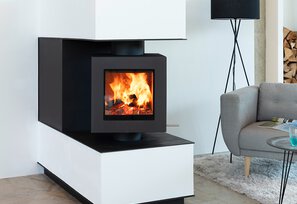The tiled stove - A stove that warms for a long time
True, but why actually? After 1-2 hours of burning time, the fire slowly goes out, by which time the outer shell of the tiled stove is just lukewarm. It does make you wonder why such a tiled stove gives off heat for 12 hours after such a short burning time. One wonders where the heat is "stored" for so long until it is completely released? We find answers inside the tiled stove, where we can take a closer look at the system.

The inner qualities of the tiled stove
In detail, the system of a tiled stove works like this: It all starts with the fire in the heating insert. Once the fire is lit, the "energy release machine" of wood starts, so to speak. The burning of the wood produces heating gases in the heating element. These heating gases contain a lot of heat energy and rise upwards due to their low density. It would be a pity to let the gases simply disappear through the chimney into the open air.
To make efficient use of the energy (this can be more than 80% efficiency!), the heating gases are directed from the combustion chamber through a path of coils with storage mass before they reach the chimney.
The storage (heat-storing material such as fireclay) can be compared to a sponge: As the heating gases flow through the fireclay coils, they give off their energy to the mass. In the process, the material fills up like a sponge until the fire in the heating insert is extinguished and the storage can absorb no more energy. The air supply to the combustion chamber is then closed, so the inside of the stove does not cool down.
In total, this "gas deflection" and complete loading of the storage takes some time. This is also the reason for the waiting time until the stove can evenly release its heat into the room.

The tiled stove as an inert but efficient system
But this inertia is also the beauty of this type of stove. During combustion, the storage absorbs the energy, but releases it again much more slowly. So you get something out of it for a long time: constant, pleasant radiant heat is emitted over 12 hours and warms deeply and soothingly.
Practical for constant heat demand is that you can take your time with the next firing due to the long heat emission. If the tiled stove is also to be used for hot water production, this can be achieved with a water-bearing system. This, combined with a heat pump, results in the most up-to-date technical heating solution with a wood fire. Modern heating technology with the cosiness and safety of a wood fire.

Conclusion
A tiled stove may take a little longer to get warm, but it gives off heat for many hours. With a water-bearing device, the heat can even be used to produce hot water.
The classic tiled stove undeniably has its advantages. To find the right heating insert for you, we recommend going to a stove manufacturer. A furnace builder can best work out with you which heating insert is perfect for you. You can find good stove construction companies under our Craftsman search.











